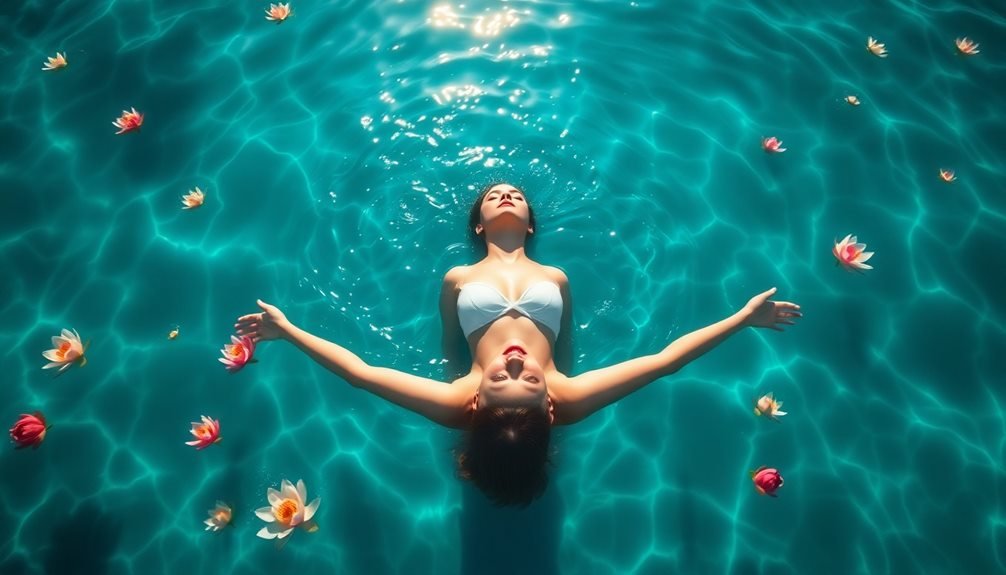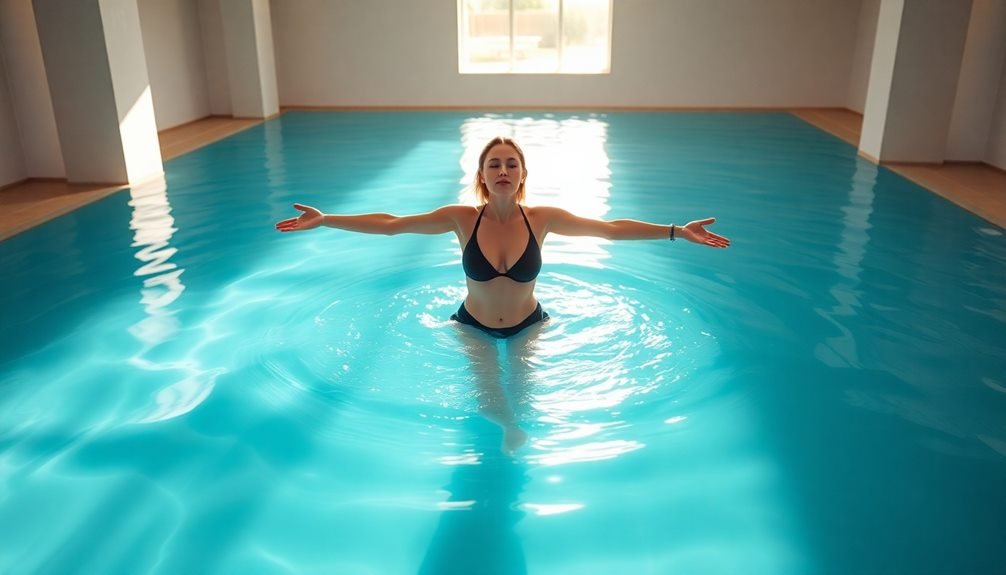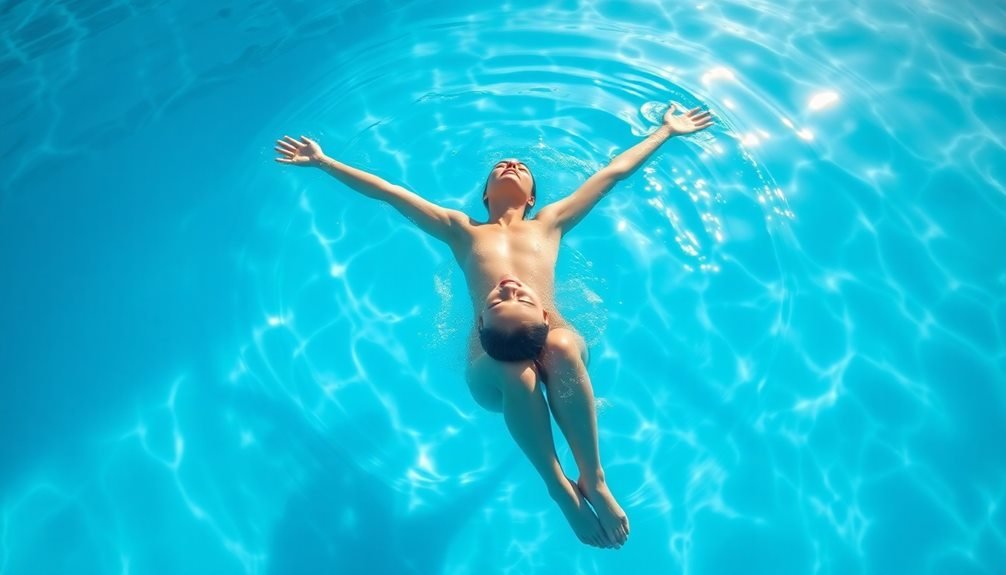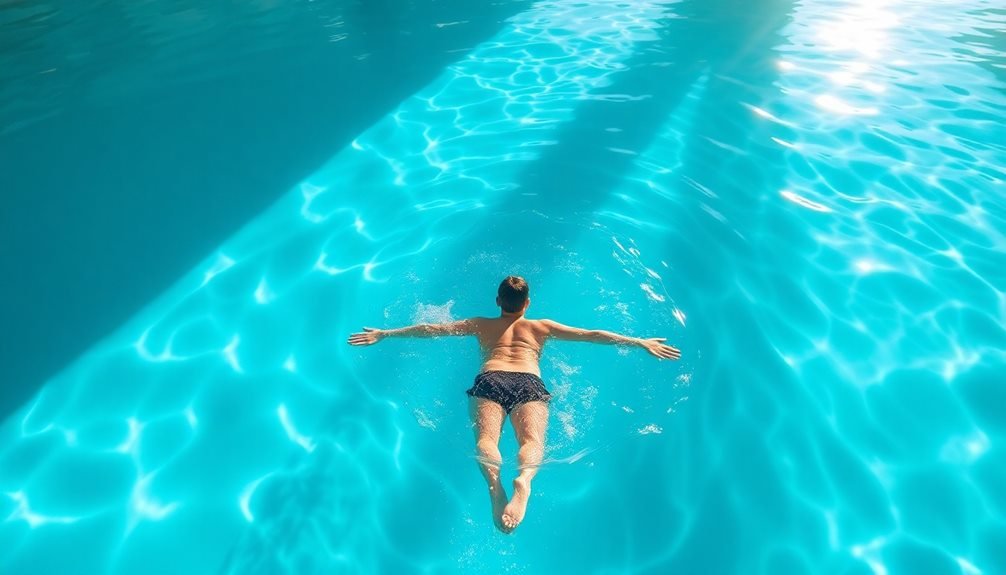Swimming provides five powerful techniques to wash away your stress and anxiety. You'll find peace through floating meditation, where weightlessness helps release tension, and rhythmic breathing laps that sync your movements with controlled breaths. Water walking offers gentle resistance while improving balance, and progressive muscle release swimming targets specific areas of tension. The mindful backstroke practice transforms your swim into a moving meditation, combining physical relief with mental clarity. These aquatic methods work together to create an all-encompassing approach that'll help you discover a deeper level of relaxation and stress relief.
The Floating Meditation Method

Serenity begins in weightlessness. As you lie back in the water, your body naturally rises to the surface, creating a sensation of floating in space. The water's gentle support eliminates the constant pull of gravity on your muscles and joints, allowing complete physical surrender.
To practice floating meditation, start in the shallow end where you can touch the bottom. Slowly lean backward while extending your arms outward, letting your ears submerge until only your face remains above water. You'll need to arch your back slightly and keep your belly lifted toward the surface.
If you're struggling to float, try taking deeper breaths – your lungs act as natural flotation devices.
Once you've found your balance, close your eyes and focus on your breathing. Feel the rhythmic rise and fall of your chest and the subtle movements of the water around you.
You can enhance this experience by using earplugs to block out external noise, creating an intimate cocoon of tranquility. Practice this technique for 5-10 minutes, allowing your mind to drift while your body remains buoyant.
The combination of physical weightlessness and mental detachment creates a unique state of relaxation.
Rhythmic Breathing Laps
Motion creates mindfulness in the pool as you synchronize your strokes with deliberate breathing patterns. Each lap becomes a structured exercise in controlled breathing, helping you establish a natural rhythm that calms both body and mind.
You'll find that focusing on this breath-stroke coordination leaves little room for intrusive thoughts or daily stressors.
Start by swimming freestyle at a moderate pace, breathing every third stroke. Exhale steadily underwater through your nose, then turn your head to the side for a swift inhale when your arm recovers.
As you become comfortable with this pattern, you can experiment with different breathing intervals – every fourth or fifth stroke – to find your ideal rhythm.
Set a goal of 10-15 minutes of continuous rhythmic breathing laps. If you're new to this technique, it's okay to rest between laps until you build endurance.
The key is maintaining consistent breath control throughout each lap. You'll notice your breathing becomes more efficient over time, and this improved oxygen flow helps reduce anxiety while enhancing your overall swimming performance.
Water Walking For Balance

Walking in water offers a gentler alternative to swimming laps while maintaining the calming benefits of aquatic movement. The water's natural resistance creates a supportive environment where you can focus on balance and posture while reducing stress on your joints.
As you move through chest-deep water, you'll feel a soothing weightlessness that helps release physical tension.
Start by walking forward in a straight line, keeping your core engaged and arms relaxed at your sides. You'll notice how the water's resistance naturally slows your movements, encouraging mindful steps and controlled breathing.
After mastering forward walking, try sidesteps, backward walking, and diagonal movements to challenge your balance and coordination.
You can increase the intensity by lifting your knees higher, speeding up your pace, or adding arm movements. For enhanced stress relief, incorporate gentle arm circles or figure-eight patterns as you walk.
If you're feeling particularly tense, try walking on your tiptoes or heels to engage different muscle groups. Remember to maintain a steady breathing pattern and focus on the sensation of water flowing around your body as you move.
Progressive Muscle Release Swimming
Mastering progressive muscle release while swimming creates a powerful combination of physical and mental relaxation. As you swim, you'll focus on tensing and releasing specific muscle groups in rhythm with your strokes, promoting deeper relaxation and stress relief.
Start by swimming freestyle at a moderate pace. Tense your shoulders for three strokes, then consciously release them for the next three. Move this pattern down to your arms, core, and legs. You'll notice how each muscle group feels different when you alternate between tension and relaxation.
When you're comfortable with individual muscle groups, combine them in sequences. Tense your shoulders and arms together for four strokes, release, then move to your core and legs. This flowing pattern helps you identify where you hold stress in your body.
As you progress, sync your breathing with these muscle releases. Inhale while tensing and exhale while releasing. You'll find that this coordinated movement enhances your body awareness and creates a meditative state.
Practice this technique for 10-15 minutes, gradually increasing duration as your comfort level improves.
Mindful Backstroke Practice

Floating peacefully on your back opens a unique gateway to mindful swimming practice. As you lie in this position, focus on how your body naturally buoys in the water, and feel the gentle support beneath you. Notice how your arms and legs remain suspended while your chest rises slightly with each breath.
Begin your mindful backstroke by coordinating your arm movements with your breathing. As one arm lifts, inhale deeply; as it pulls through the water, exhale steadily. You'll want to maintain a steady rhythm that doesn't disturb your floating position. Keep your neck relaxed and your gaze directed straight up, allowing your ears to stay partially submerged.
While performing the backstroke, pay attention to each sensation: the water streaming past your fingers, the subtle rotation of your shoulders, and the light splash of your kick. If your mind wanders, gently bring your focus back to your body's movement through the water.
This practice isn't about speed or distance – it's about staying present with each stroke. You'll find that this mindful approach transforms your backstroke into a moving meditation, releasing tension and promoting mental clarity.
Frequently Asked Questions
What Type of Swimwear Is Best for Stress-Relief Swimming Exercises?
You'll want to wear comfortable, well-fitting swimwear that doesn't restrict movement. Choose chlorine-resistant materials like polyester or nylon blends, and make certain your suit provides proper support and coverage during exercises.
How Long Should Each Aquatic Stress-Relief Session Last for Optimal Benefits?
You'll get ideal stress-relief benefits from 30-45 minutes in the water. If you're new to swimming, start with 15-20 minutes and gradually increase your time as your stamina improves.
Can Stress-Relief Swimming Techniques Be Practiced in Any Depth of Water?
You'll need at least chest-deep water for most stress-relief swimming techniques, but you shouldn't exceed depths where you feel unsafe. Shallower water works for basic floating and gentle movements only.
Is It Necessary to Be a Strong Swimmer to Perform These Exercises?
You don't need to be a strong swimmer to try stress-relief exercises in water. You'll want basic swimming abilities and comfort in water, but many techniques can be done in shallow, controlled environments.
What Water Temperature Is Ideal for Stress-Relief Swimming Activities?
You'll feel most comfortable swimming in water between 78-82°F (26-28°C). This temperature range helps you relax without feeling too cold or too warm during your water activities. It's ideal for stress relief.
In Summary
You'll find these five aquatic stress-relief techniques can transform your swimming routine into a powerful mental health tool. Whether you're floating peacefully, focusing on breath-synchronized laps, or practicing mindful movements, the water offers a unique environment to wash away tension. Make these exercises part of your regular wellness routine, and you'll discover why the pool might become your favorite stress-management destination.





Leave a Reply